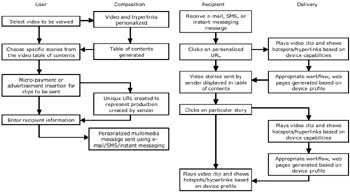7. Sharing Interactive Experiences
7. Sharing Interactive Experiences
Unlike text-based messages, multimedia messaging brings unique challenges. Multimedia messages can originate from large display terminals such as PCs and be sent to devices with limited capabilities like handheld phones. In the case of multimedia messages, the sender cannot have the complete confidence that the recipient will be able to watch the multimedia message for any one of the following reasons:
-
Display constraints
-
Processing constraints
-
Bandwidth constraints
-
Streaming media player platform
In the reverse case, the sender might have limited device or network capabilities while the recipient(s) might have better display devices and might be able to experience a richer multimedia experience, which the sender could not. For instance, the sender might not have the capabilities to view hyperlinks embedded into the video on his handheld PDA, but there is no reason why the recipient should not be able to experience rich multimedia on his PC when viewing the same content. This shows that there is a need for content adaptation based on device capabilities at both the sender and receiver terminals. The service provider or the content provider should have software which would recognize the capabilities of the client terminal making the request and adapt the multimedia presentation for that terminal.
User mobility creates a demand for location-based services. In most messaging scenarios, the sender and the recipient are at different locations. This provides an opportunity for the content provider to provide location-based advertisements, for instance, along with the actual message content but where the advertisement is based on the location of the receiver of the message rather than the sender.
7.1 Sharing Personalized Content
The Personalized Multimedia Messaging Service (PMMS) initiative at Siemens Corporate Research adds experience-sharing features to the HotStreams™ architecture by allowing end-users to share particular video stories from customized productions. The messaging module allows an end-user to send a customized production to various recipients. The personalization and adaptation module helps in adapting the multimedia presentation to the recipient's device, streaming platform, bandwidth, network, and location. Many of the features being used by PMMS were also used in the SEMCA application to facilitate experience sharing between the customer and the customer support agent. Figure 16.14 shows the composition workflow and the delivery workflow involved in the experience sharing.

Figure 16.14: The Experience Sharing Workflows
For the recipient to experience the multimedia message as the sender had meant to, PMMS has to adapt the content based on several factors:
Streaming Platform
PMMS utilizes the HotStreams™ content management tools described earlier to manage media files available for streaming. On various mobile devices, the multimedia capabilities are usually limited to one of the popular streaming platforms. Moreover, most the devices come bundled with a particular media player installed. In the mobile phone video streaming, a new crop of media players based on MPEG4 format, such as PacketVideo, have made their entry. If the sender and recipient are using different video streaming platforms, the message sent by the sender may not be rendered on the recipient's device. PMMS tries to identify the device or the operating system and serves the video file in appropriate format (e.g., Windows Media streaming on the Windows CE platform).
Device and Network Constraints
PMMS utilizes the workflow described earlier in this chapter to adapt the content to the device and network capabilities of the recipient.
Location-based Services
PMMS utilizes location information in providing location related information within the message. PMMS can, for instance, insert location-based advertisements in the recipient's video production in cases where the stories are free to the sender. Assume, for instance, that the sender in Italy wishes to share a couple of video clips to a mobile phone user in the USA. PMMS may insert USA related advertisements into the video production before delivery to the recipient. The hotspots included in the video advertisements would similarly point to appropriate websites for that location.
7.2 Tools
The workflows shown in Figure 16.14 needed to be supported by tools for the sender to compose the multimedia message used to share experience and tools for delivering the shared experience to the recipient.
7.2.1 Composition Tools
PMMS and SEMCA provide webpages from which the sender can select the video sections that will be part of the content to be shared and for typing the recipients' addresses and a short text message to be included in the e-mail. The application server interfaces a mail server transferring the generated e-mail message to the recipients.
7.2.2 Delivery Tools
The PMMS and SEMCA application servers also implement the tools needed to respond to recipients' requests for shared content and for adapting the content to the recipients' capabilities.
EAN: 2147483647
Pages: 393